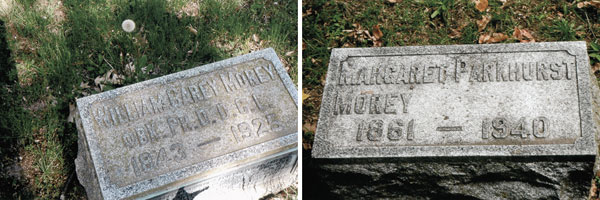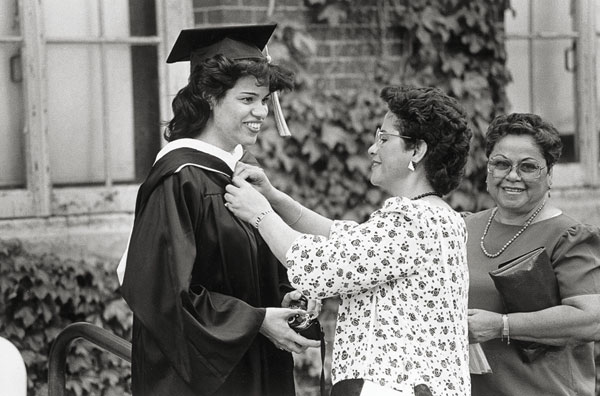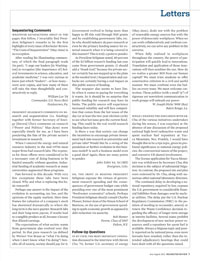Letters
Sequestering Comments
Whatever satisfactions await in the pages that follow, I invariably find President Seligman’s remarks to be the first highlight of every issue of Rochester Review. “The Costs of Sequestration” (May-June) is no exception.
After reading his illuminating commentary, of which the final paragraph reads (in part), “I urge our leaders [in Washington] to recognize [the importance of] federal investments in science, education, and academic medicine,” I was very curious to know just which “leaders”—or how many—were sent copies, and how many of them will take the time thoughtfully and constructively to reply.
William Lee ’54
Commander, U.S. Navy (Ret)
Doylestown, Pa.
President Seligman’s comments on Research and sequestration (i.e. funding) together with former Secretary of Energy [Steven] Chu’s comments on research (“Power and Politics,” May-June) were especially timely for me, as I have been pondering the fate of the private sector’s investment in research.
When I entered the energy and natural resource industry in the mid–1970s most major firms had research labs. The expenses for these efforts were considered to be a necessary cost of doing business to be funded annually without question. Industrial funding of academic research at many universities augmented these programs.
Fast forward to this decade. With very few exceptions these labs have been closed. Why and what is replacing this basic research?
Perhaps one answer is the impact of the evolution in accounting, tax law, and the opinions of the equity markets. Here time frames for valuation of a company’s stock has shortened dramatically to where the long term is the next quarter. Research labs and their long-term payout, if results lead to a tangible product at all, became a luxury that diluted earnings.
The expectations of what society wants from government also evolved over this period. In that pure research (as defined by Werner Von Braun as “what I’m doing when I don’t know what I’m doing”) benefits all of society, society should pay for it. Government evolved to being more than happy to fill this void through NSF grants and by establishing government labs, etc. So why should industry do pure research or even be the primary funding source for external research when it is being covered in this manner? This is truly a point to ponder.
As President Seligman noted, 80 percent of the $2 billion research funding last year came from government grants. (I should add a “thank God,” because the private sector certainly has not stepped up to the plate at the needed level.) Sequestration and cutbacks are certainly having a real impact on this public source of funding.
The taxpayer also seems to have limits when it comes to paying for everything it wants. So it should be no surprise that public funding for research may have its limits. The public source will experience increased volatility and will face competition that comes from the hot issues of the day (or at least the two-year election cycle) to see what hot issue gets the current funding. This could be the real world research funding faces today.
Is there a way that society can change the incentives to encourage private investment back into research at universities and private labs? Would this be a swing of the pendulum or further evolution in this business model? Is such a business model even a good idea? Again, these are many points to ponder.
John Tobin ’64, ’64 (MS)
Evergreen, Colo.
Oh, the irony in reading President Seligman espouse the virtues of government research spending and the consequences of government budget cuts while presiding over one of the most prominent “freshwater economics” schools. Perhaps President Seligman should consult Charles Plosser, former dean of the Simon School of Business, on the use of government spending to spark economic growth as opposed to debt reduction via austerity.
Bob Hunter
Parent, Class of 2007
Fulton, N.Y.
Follow-Up Questions
In my view, the most important innovation discussed in the interview with Steven Chu ’70, former U.S. secretary of energy (May-June), deals not with the problem of renewable energy sources but with the power of democratic workplaces. When we can work collaboratively and confront constructively, we can solve any problem in the universe.
When fully realized in workplaces throughout the country, the power of participation will quickly lead to innovations. Translation and application of those innovations will then outshine the sun. How do we realize a greater ROI from our human capital? We must train students to offer constructive criticism in a civil and useful manner. We must confront even the bullies on every team. We must welcome correction. These politics (with a small “p”) of rigorous yet nonviolent communication in work groups will unleash our power.
W. Joseph Hicks ’89M (Res)
Baton Rouge, La.
While I enjoyed the discussion with Dr. Chu of the various initiatives undertaken during his tenure, I was surprised at the absence of any discussion of the proposed national high-level radioactive waste and spent nuclear fuel repository at Yucca Mountain, Nev. Frankly, I would have thought this to be a ripe topic, given its profound significance to national energy policies, the controversial nature of the project, and extensive UR alumni involvement.
The license application for Yucca Mountain was withdrawn by Secretary Chu; this decision is the subject of substantial litigation. In contrast, the proposed site and plan were endorsed by Dr. Chu, along with numerous other national laboratory directors.
The continued delay in developing a national repository, required by law, exposes the U.S. government to considerable financial liabilities from damages won by nuclear utilities. The delay put the U.S. Nuclear Regulatory Commission (NRC) in the position of needing to reconsider, amend, or renew the Waste Confidence decision regarding the efficacy of longer term storage at interim facilities. Several states prohibit the development of new nuclear power resources until a repository for spent fuel is available. Always a litigious topic and poorly reported on by national press, even more lawsuits have resulted, rather than the intended adjudicatory hearings that could have dealt with all the questions raised.
This summary is, of course, a small subset of the issues and does not address the myriad scientific and technical questions attending nuclear energy policy generally and Yucca Mountain particularly.
Given the roles of UR geology grads like Allison Macfarlane ’87, current chair of the NRC, Bret Leslie ’83, and myself, and no doubt others of whom I am regrettably unaware, I would have thought this to be a choice issue for such a great discussion opportunity with Dr. Chu.
Gene Peters ’87
Springfield, Va.
The writer is a former branch chief of the U.S. Nuclear Regulatory Commission.
War Stories
It strikes me as odd that Steven Hahn ’73 (“The Forge of a New Nation,” May-June) does not consider the glaringly obvious third option in the run up to the Civil War—let the southern states secede. Of course this would not have eliminated slavery or improved the lot of black people in the South. But just think of the kind of country the United States could have been without the drag of the reactionary strains that historically informed, and continue to inform, the southern worldview and cultural values?
Instead of fighting or further compromising, the North could have rejected Dred Scott, enforced abolition in all territories, and granted American citizenship to any person of African descent who managed to cross Union borders.
And yes, the abominations of slavery might well have persisted into the 20th century until the South caught up with the rest of the so-called civilized world. But just think of the light unto the world that our country could truly have been without the South.
Bill Glasner ’69
Victor, N.Y.
Your article “On Cemetery Ridge,” (May-June) mentions Capt. Winfield Scott, Class of 1859, several times, but does not state if he was any relation of Gen. Winfield Scott (1786–1866), the “Grand Old Man of the Army” and an unsuccessful candidate for president.
Was Capt. Scott named for the general? Were they related?
Dennis Rothman
Parent, Class of 2015
Tenafly, N.J.
Author Bob Marcotte writes: There appears to be no connection other than coincidence. The general is not listed as part of the Scott family genealogy by Captain Scott’s biographer, Richard Lynch. He also makes no mention of the captain being named in honor of the general. Captain Scott was born in 1837, well before General Scott emerged as a national hero after the Mexican-American War of 1846–48, but one year after General Scott commanded forces in the Second Seminole War and Creek War.
 MOREYS: William Morey, namesake of Morey Hall and a Civil War veteran, and his wife, Margaret Parkhurst, are buried in Michigan. (Photo: Courtesy of Martha McRoberts Bartlett)
MOREYS: William Morey, namesake of Morey Hall and a Civil War veteran, and his wife, Margaret Parkhurst, are buried in Michigan. (Photo: Courtesy of Martha McRoberts Bartlett)The recent issue of Rochester Review, which included a page from the diary of Professor [William] Morey, reminded me that I had seen his grave here in Coldwater, Mich. He is buried in Oak Grove Cemetery, next to his wife, Margaret, the daughter of Gen. John Parkhurst of Civil War fame.
I have enclosed several articles and photos about the Moreys and the Parkhursts, though I do not see when or where Professor Morey met Margaret Parkhurst. Perhaps it was during the time he taught at Kalamazoo College, about an hour from Coldwater.
Coincidently, their marriage took place at St. Mark’s Episcopal Church here, which is the church where my husband, Steve, served as rector during the past 13 years. Since 2001, I served as the director of Family Promise of Branch County, helping families who are homeless achieve independence. Both of us retired during the past year and look forward to new adventures.
Martha McRoberts Bartlett ’68
Coldwater, Mich.
P.S. Isn’t it wonderful that a dandelion has bloomed behind Professor Morey’s headstone!
Historical Notes
How come your historians’ discussion of the Reformation (“Schismatics, New and Old,” May-June) didn’t include in their remarks the greatest development stemming from it and its sister movement, the Enlightenment, i.e., the concept of liberalism?
This is important for its emancipation of human thought from the stifling influence of the medieval Catholic Church, which resulted in, among other things, the explosion of scientific discovery, whose benefits I don’t have to mention. Today, we are still fighting that battle against the rubric of conservatism which the Republican Party and the present Catholic Church are aggressively pushing.
By the way, I was greatly impressed with your informative history of the key role Rochester students played in the pivotal Battle of Gettysburg. The University should commemorate their role with some kind of formal display akin to what Harvard did in its display of the names of Harvard students in the Civil War that can be found in Sanders Theater in Harvard Square.
Berge Tatian ’51
Stoneham, Mass.
Students and alumni who fought in the Civil War are memorialized in Wilson Commons, where inscribed plaques list the names of alumni who died in the Civil War, World War I, World War II, Korea, and Vietnam. The Civil War memorial was originally in Anderson Hall on the Prince Street Campus.—Scott Hauser
Musical Notes
I very much enjoyed reading about the University’s proactive stance in becoming involved in the massive online open course (MOOC) movement (“Cataloging a Course,” May-June). I enrolled in Professor John Covach’s History of Rock, Part 1, on Coursera. Congratulations are due to him and to the University staff for producing a course with such great material, teaching, and production. I enjoyed learning in this format. I believe it is here to stay and will only expand. One of the goals of education is to disseminate knowledge broadly, and this platform certainly offers that potential. On a lighter note, I believe I may be the only student to have taken The History of Rock twice at the U of R, almost 40 years apart—taught by different professors and in different “platforms.” There is now music to study beyond the Beatles and the Grateful Dead!
What a wonderful thing!
Richard Rubin ’77
Slingerlands, N.Y.
 PRIMP & CIRCUMSTANCES: Diana Santiago ’85 and her mother, at commencement ceremonies in 1985. (Photo: University Libraries/Department of Rare Books, Special Collections, and Preservation)
PRIMP & CIRCUMSTANCES: Diana Santiago ’85 and her mother, at commencement ceremonies in 1985. (Photo: University Libraries/Department of Rare Books, Special Collections, and Preservation)Photo ID
The graduate in the Class Notes photo on page 50 (May-June) is Diana Santiago ’85 and her mom with her aunt looking at the camera. Diana was in our wedding in 1988 and is now an anesthesiologist in the New York City area.
Walter ’86 and Kim Radoane Kerschl ’87
Lexington, Va.
It’s been 28 years since graduation but, if I’m correct, the person graduating in the photo on page 50 of the May-June issue is Diana Santiago ’85. At least one of the guests has to be her mom. Diana was a friend all through college and lived in the single next door to my own our senior year.
Forrest Strauss ’85
Monroe, N.Y.
Remembering Margaret Bond
Kudos to Robert Kraus ’71 for his moving tribute to Margaret Bond ’47 (May-June).
Bondi, as we called her when she edited Gallery Notes for the Memorial Art Gallery, was a writer’s ideal editor— thorough but gentle and with unfailing ironic humor. You could always spot the perfect turn of phrase that was her suggestion.
Margaret could write as well as edit, witness her gem on the feathers incident in Eastman Theatre or her masterful obituary of Howard Hanson.
I suspect that I am not the only one with a stack of old Rochester Reviews in the corner of her library that are “keepers” because of their inimitable creator or editor.
Elizabeth Brayer
Rochester
Well Said
Kudos to Kathleen McGarvey for her articles, “Libraries Unbound” and “A Vanishing Past?,” in the March-April edition. Well written and insightful.
Nicely done!
Mack Duett
Parent, Class of 2005
East Syracuse, N.Y.
Who Speaks for the Squash?
So few take time to even dash off a note in appreciation of work well done that I must put off planting the squash and do so now.
Masterful work on the last Rochester Review. I don’t know how you do it. When I read it, I remember thinking that putting a magazine together like that was art—which cannot be learned.
I’m putting in the squash. Thanks again for contributing to our educations.
Robert Karl Skoglund ’70 (MA)
aka The humble Farmer
St. George, Maine
Review welcomes letters and will print them as space permits. Letters may be edited for brevity and clarity. Unsigned letters cannot be used. Send letters to Rochester Review, 22 Wallis Hall, P.O. Box 270044, University of Rochester, Rochester, NY 14627-0044; rochrev@rochester.edu.

